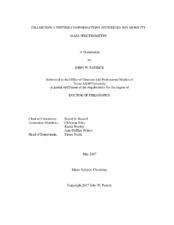| dc.description.abstract | One of the most rapidly advancing subjects studied by analytical chemistry, biology, and biophysics is the analysis of membrane associated peptides and proteins from a native lipid environment. Mass spectrometry (MS) has been employed for many years as a tool to characterize the molecular weight, sequence, or modifications to these peptides and proteins, however MS alone does not provide information on the conformation adopted by a peptide or protein in the membrane. Here, novel sample preparation methods to probe the solution phase structure of dimerized Gramicidin A (GA) inserted into lipid vesicle bilayers are described. These methods, termed vesicle capture-freeze drying (VCFD) and mixing tee- ESI (MT-ESI), when coupled with electrospray ionization ion mobility mass spectrometry (ESI-IM-MS), successfully demonstrate the first evidence for the preservation of membrane-bound structure in the analysis of solution-phase conformers retained into the gas phase. The extremely hydrophobic character of GA ensures that only membrane-bound conformations are captured and subsequently monitored when samples are prepared using VCFD, removing a barrier that has prevented previous attempts at direct analysis using mass spectrometry. Solution-phase physicochemical interactions of GA influenced by lipid acyl chain length and extent of acyl chain unsaturation can now be probed by monitoring the conformer preferences using IM-MS. Conformer preferences adopted in the lipid bilayer are maintained as GA dimers travel from the solution phase to fully desolvated gas-phase ions, demonstrating that distributions observed using ESI-IM-MS unambiguously reflect the ensemble of conformers observed in the solution phase. The required time for GA sample preparation was decreased by approximately 50% using MT-ESI when compared to VCFD sample preparation; however, comparable conformer preferences were obtained using both techniques. GA analogues that contain leucine to lysine substitutions were analyzed; these analogues yielded more hydrophilic GA dimers owing to the hydrophilicity of lysine head groups. The conformer preferences of lipid bilayer associated hydrophilic GA analogues can be obtained owing to disassociation of lipids during the fast mixing time MT-ESI process. Both VCFD and MT-ESI coupled to IM-MS yield novel biophysical insight into the influence of lipid bilayer membranes on conformer preferences and conformer heterogeneity of an important channel-forming membrane peptide. | en |


